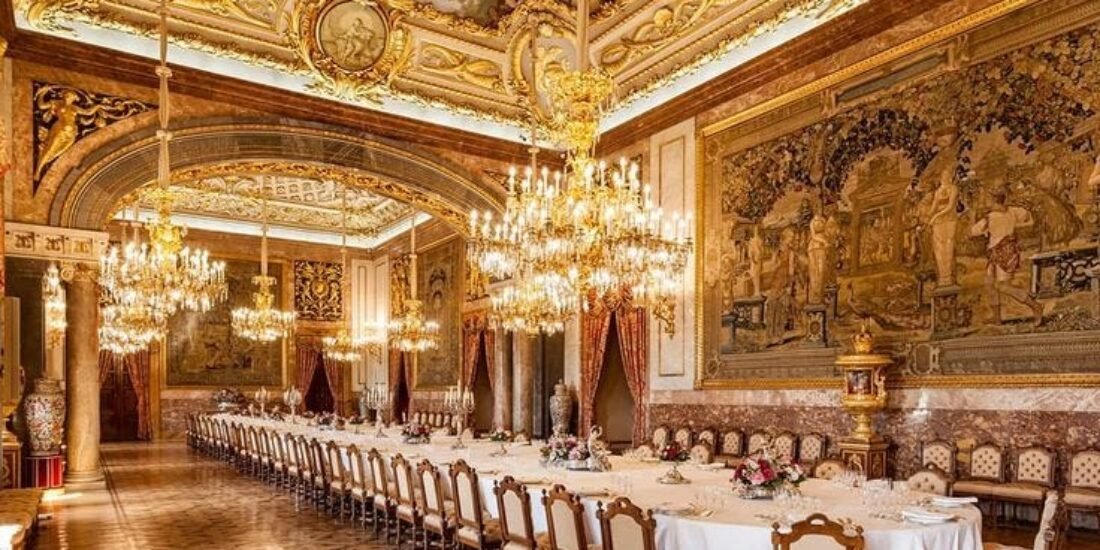The dining hall in Falaknuma Palace is a key feature, reflecting both the grandeur of the Nizam’s era and the architectural splendor of the palace. Here’s a detailed look at the significance of the dining hall:
1. Architectural and Design Significance
- Grand Scale: The dining hall is one of the largest in the palace, showcasing the scale and opulence that characterized the Nizam’s lifestyle. Its spacious design underscores the importance of dining as a social and ceremonial activity.
- Elegant Décor: The hall is renowned for its exquisite décor, including ornate ceiling designs, grand chandeliers, and intricate woodwork. The high ceiling, large windows, and elaborate detailing contribute to an atmosphere of grandeur.
2. Symbol of Opulence
- Reflecting Wealth: The dining hall symbolizes the wealth and status of the Nizam of Hyderabad. The luxury and scale of the hall are reflective of the Nizam’s opulent lifestyle and his appreciation for fine dining and grand events.
- Hosting Dignitaries: The hall was used to host important dignitaries, foreign guests, and royal family members, making it a venue for high-profile social and political gatherings.
3. Cultural and Social Importance
- Royal Banquets: The dining hall was the setting for lavish banquets and feasts, showcasing the culinary traditions of the region and the Nizam’s hospitality. These events were often grand affairs, involving elaborate menus and ceremonial practices.
- Cultural Gatherings: The hall served as a space for cultural gatherings, including celebrations of important festivals and events, where the Nizam could showcase his hospitality and the rich cultural heritage of Hyderabad.
4. Architectural Features
- Dining Table: One of the most notable features is the grand dining table, which is said to be one of the largest in the world. The table, made of rosewood and intricately carved, can seat numerous guests and reflects the grandeur of royal dining.
- Chandeliers and Mirrors: The hall features large crystal chandeliers and decorative mirrors, adding to the opulent ambiance. The lighting and reflective surfaces enhance the sense of space and luxury.
- Art and Craftsmanship: The dining hall includes high-quality craftsmanship in its woodwork, ceiling designs, and decorative elements, demonstrating the artistry and skill of the artisans who worked on the palace.
5. Modern Usage
- Hospitality: Today, the dining hall continues to be used for special events and high-profile functions at the Taj Falaknuma Palace. It serves as a venue for exclusive dining experiences, blending historical charm with modern luxury.
- Culinary Experiences: As part of the luxury hotel, the dining hall hosts gourmet dinners and special events, offering guests a taste of royal dining traditions combined with contemporary cuisine.
6. Historical Significance
- Historical Events: The dining hall has been the site of numerous historical events and ceremonies. It stands as a testament to the opulence of the Nizam’s court and his commitment to hosting grand and memorable events.
- Preservation: The preservation of the dining hall and its features is crucial for maintaining the historical integrity of the palace. It reflects the cultural and architectural heritage of Hyderabad and provides visitors with a glimpse into the grandeur of the Nizam’s era.
Summary
The dining hall in Falaknuma Palace is significant both as an architectural marvel and a symbol of the Nizam’s opulence. Its grand design, luxurious décor, and historical usage highlight its importance in the palace’s overall layout and the Nizam’s lifestyle. Today, it continues to be a prominent feature of the palace, serving as a venue for high-end events and offering a glimpse into the grandeur of Hyderabad’s royal past.

